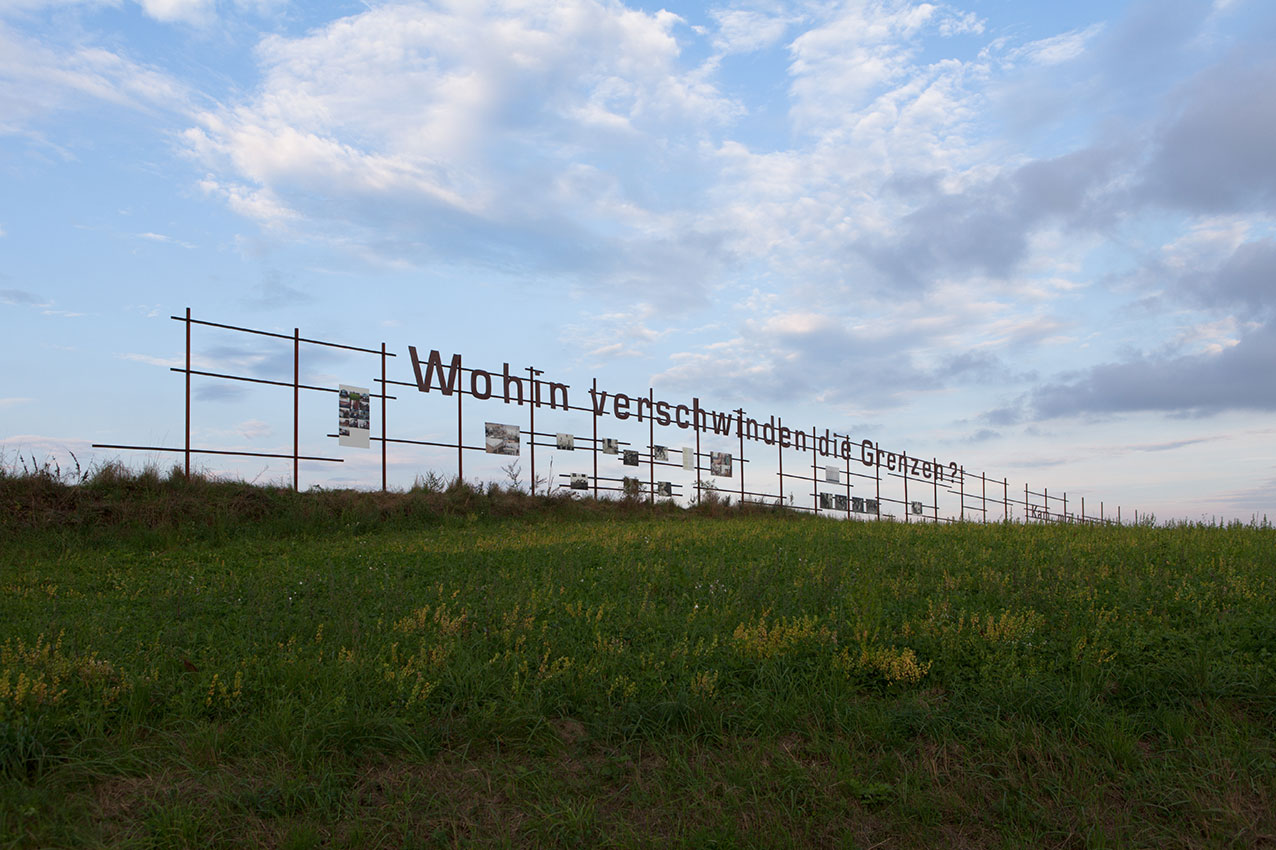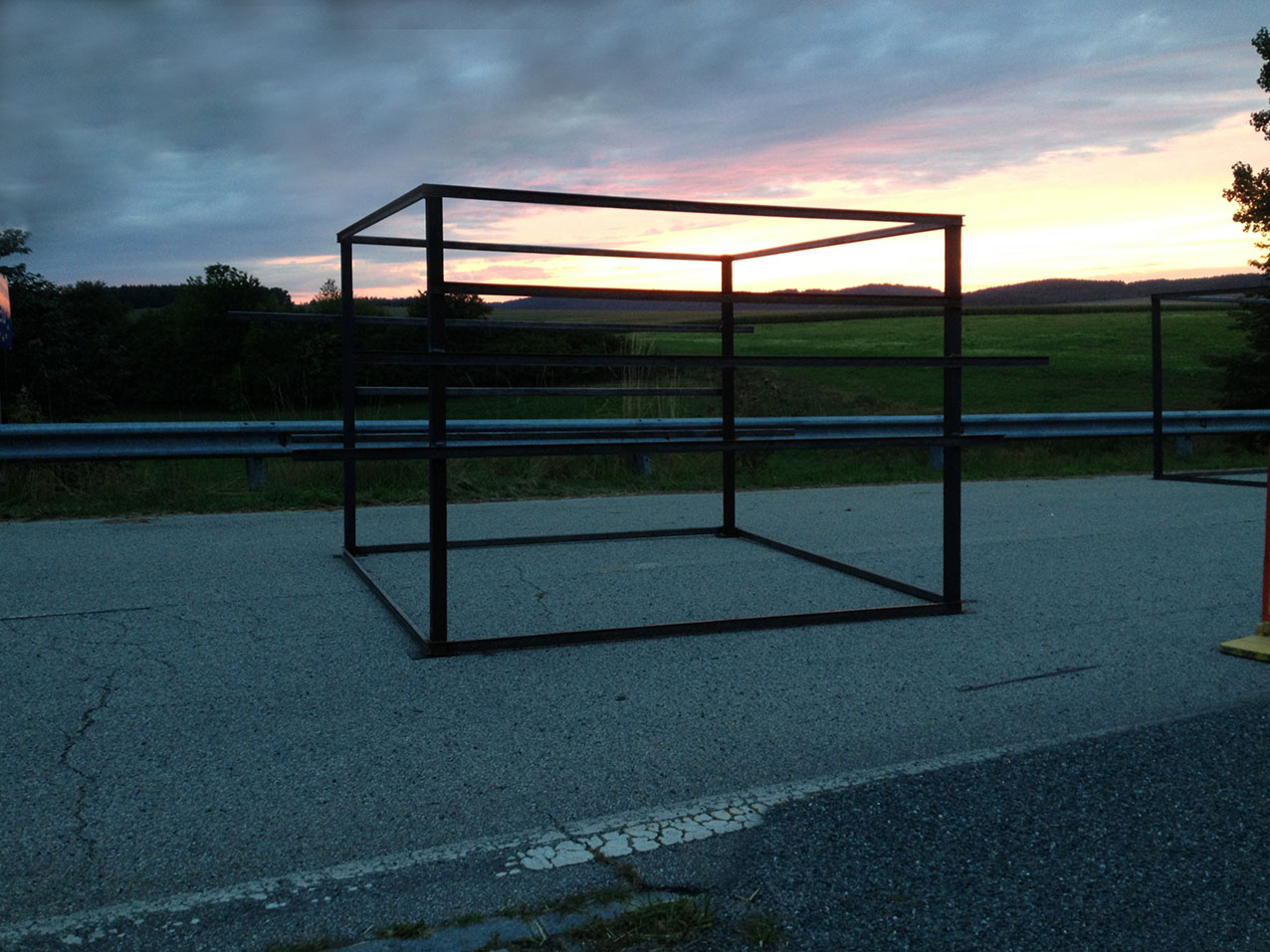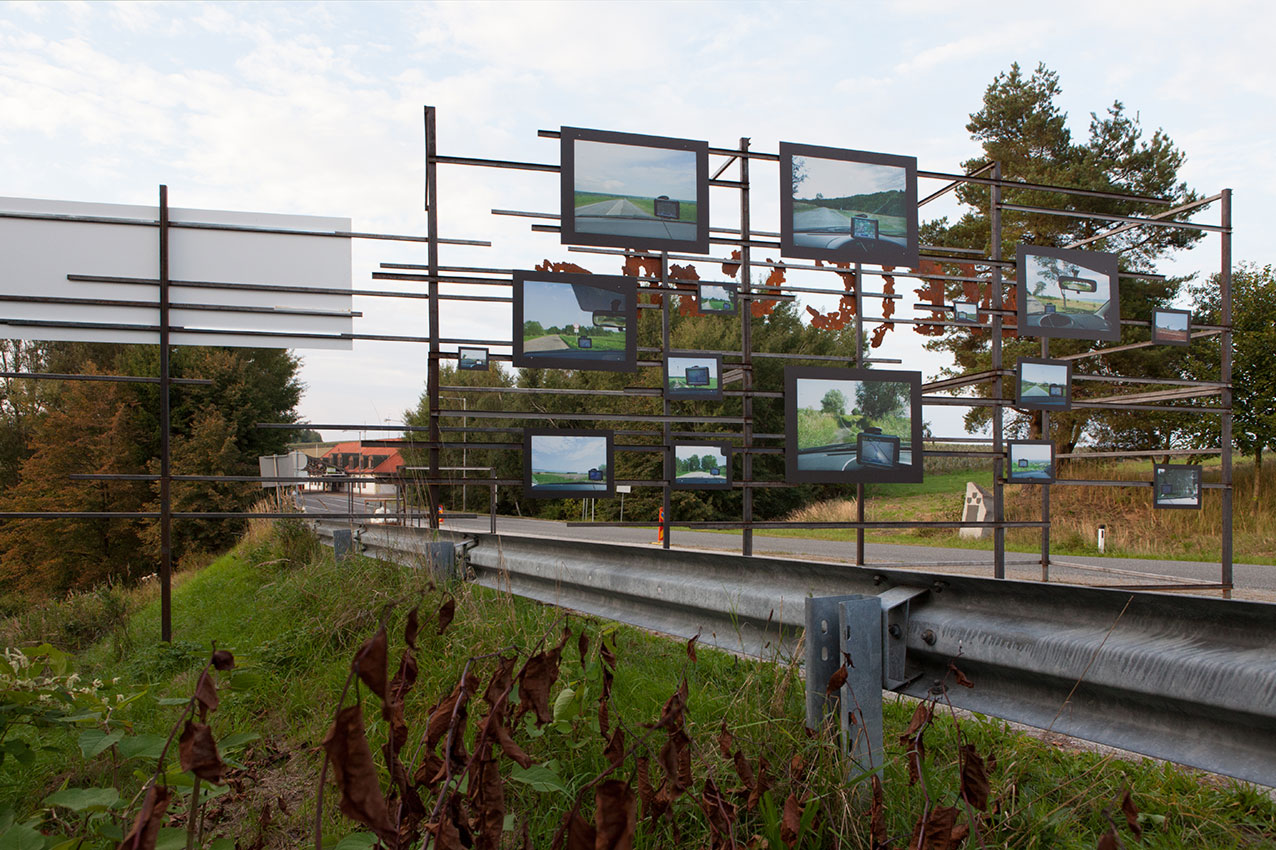Wohin verschwinden die Grenzen / Kam Mizí Hranice?
Installation and Exhibition at the Border between Fratres and Slavonice
By Iris Andraschek and Hubert Lobnig
With works by Katrin Hornek, Lukáš Houdek, Agnieszka Kalinowska, Franz Kapfer, Abbé J. Libansky, Zbigniew Libera, Heidi Schatzl, and Johanna Tinzl & Stefan Flunger
After the fall of the Iron Curtain, we celebrated a Europe without borders. Then, after the expansion of the European Union and the signing of the Schengen Agreement on April 28, 1995, visible border facilities began to be dismantled within a certain timeframe. As a result, around the year 2010, the border buildings along Austria’s borders with the Czech Republic, Slovakia, Hungary, and Slovenia were sold, and the gates, border patrol booths, and the freestanding roofs were dismantled and scrapped. Since the turn of the millennium, this has been accompanied by a gradual rise in the protection and surveillance of the EU’s external borders. “Fortress Europe” began trying to barricade itself from intruders along its external borders, charging international security firms with the surveillance of these borders. Meanwhile, every day people were drowning in the Mediterranean Sea. The borders in Morocco and the Italian island of Lampedusa have become symbols of refugees fleeing from Africa to Europe.
Beginning in 2015, with the swell of a major wave of refugees that primarily caused by the unstable situation in the Arab world and the burgeoning war in Syria, a brief period of friendly helpfulness was followed by a sudden turn in the opposite direction. The opening and dismantling of the borders, which had already been celebrated (for example, in the 25th anniversary), was questioned and partially rescinded. Within the EU, a broad spectrum of opinions concerning the admission of refugees were voiced. Hungary built a fence on its southern border, and Austria began to construct fences and barriers at strategic points. Border stations that had long been abandoned were manned again, and the state intensified identity, transport, and transit patrols on streets and freeways. Agreements and provisions for preventing and/or deterring “streams of refugees” were negotiated with neighboring countries and implemented overnight.With this in mind, the question “Where Do the Borders Go?” which we installed on a slope only a few meters away from the historically important, former border crossing between Fratres, Austria, and Slavonice, Czech Republic, in 2009, seems less paradoxical and ambivalent today than it did at the time. If the borders were truly vanishing, we would not have to ask where they were going. They have been ceaselessly moving and disappearing, only to reemerge somewhere else. Borders have become the most visible and palpable along the EU’s external borders, where they have taken the form of gigantic barriers with barbed-wire fences, surveillance systems, collection centers and camps, as well as strict patrols of people and goods—all far away from the original historical borders.
By Iris Andraschek and Hubert Lobnig
With works by Katrin Hornek, Lukáš Houdek, Agnieszka Kalinowska, Franz Kapfer, Abbé J. Libansky, Zbigniew Libera, Heidi Schatzl, and Johanna Tinzl & Stefan Flunger
After the fall of the Iron Curtain, we celebrated a Europe without borders. Then, after the expansion of the European Union and the signing of the Schengen Agreement on April 28, 1995, visible border facilities began to be dismantled within a certain timeframe. As a result, around the year 2010, the border buildings along Austria’s borders with the Czech Republic, Slovakia, Hungary, and Slovenia were sold, and the gates, border patrol booths, and the freestanding roofs were dismantled and scrapped. Since the turn of the millennium, this has been accompanied by a gradual rise in the protection and surveillance of the EU’s external borders. “Fortress Europe” began trying to barricade itself from intruders along its external borders, charging international security firms with the surveillance of these borders. Meanwhile, every day people were drowning in the Mediterranean Sea. The borders in Morocco and the Italian island of Lampedusa have become symbols of refugees fleeing from Africa to Europe.
Beginning in 2015, with the swell of a major wave of refugees that primarily caused by the unstable situation in the Arab world and the burgeoning war in Syria, a brief period of friendly helpfulness was followed by a sudden turn in the opposite direction. The opening and dismantling of the borders, which had already been celebrated (for example, in the 25th anniversary), was questioned and partially rescinded. Within the EU, a broad spectrum of opinions concerning the admission of refugees were voiced. Hungary built a fence on its southern border, and Austria began to construct fences and barriers at strategic points. Border stations that had long been abandoned were manned again, and the state intensified identity, transport, and transit patrols on streets and freeways. Agreements and provisions for preventing and/or deterring “streams of refugees” were negotiated with neighboring countries and implemented overnight.With this in mind, the question “Where Do the Borders Go?” which we installed on a slope only a few meters away from the historically important, former border crossing between Fratres, Austria, and Slavonice, Czech Republic, in 2009, seems less paradoxical and ambivalent today than it did at the time. If the borders were truly vanishing, we would not have to ask where they were going. They have been ceaselessly moving and disappearing, only to reemerge somewhere else. Borders have become the most visible and palpable along the EU’s external borders, where they have taken the form of gigantic barriers with barbed-wire fences, surveillance systems, collection centers and camps, as well as strict patrols of people and goods—all far away from the original historical borders.
Borders have become, and are still becoming, visible in the form of guarded and gated communities, in discussions about (im)migration and the right of residence, in security measures, and in deportation.
The metal construction bearing the question “Where Do the Borders Go? / Kam mizí hranice?” was first erected in 2009. The metal structure is 4 meters high and more than 50 meters long. It serves as a display board, while also highlighting the public and private strategies of keeping people separate. For two years, a photographic artwork hung there, which we had staged with regular people with immigrant backgrounds living in the Czech city of Čížov (where one of the last pieces of the Iron Curtain still stands as a kind of memorial). This work, which slowly became bleached by wind and weather, was finally taken down in the fall of 2011.
In 2014, it seemed logical to resume, expand, and continue this project, because the discussion in the EU about borders had also become more pressing. We seemed to have become a little freer within the EU after 1989, but around 2014, a general uneasiness took hold in face of the newly erected fences and walls in other places.



The metal construction bearing the question “Where Do the Borders Go? / Kam mizí hranice?” was first erected in 2009. The metal structure is 4 meters high and more than 50 meters long. It serves as a display board, while also highlighting the public and private strategies of keeping people separate. For two years, a photographic artwork hung there, which we had staged with regular people with immigrant backgrounds living in the Czech city of Čížov (where one of the last pieces of the Iron Curtain still stands as a kind of memorial). This work, which slowly became bleached by wind and weather, was finally taken down in the fall of 2011.
In 2014, it seemed logical to resume, expand, and continue this project, because the discussion in the EU about borders had also become more pressing. We seemed to have become a little freer within the EU after 1989, but around 2014, a general uneasiness took hold in face of the newly erected fences and walls in other places.




